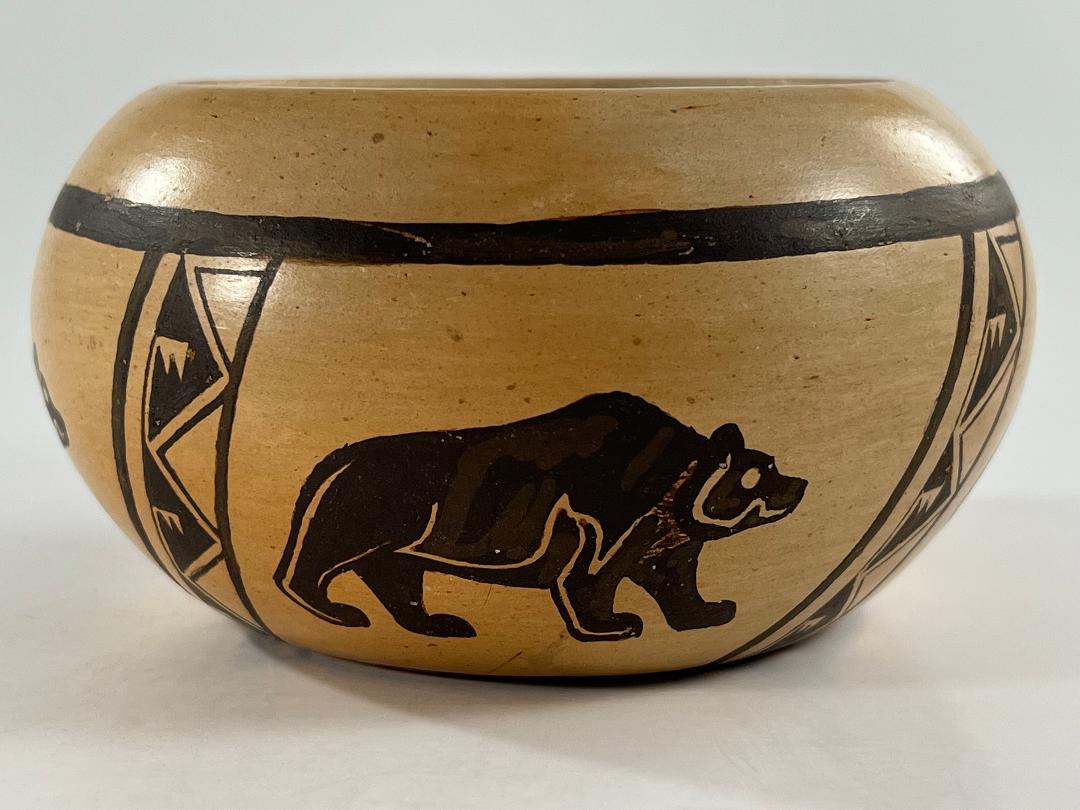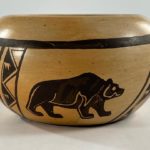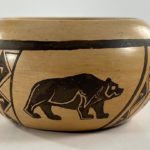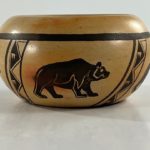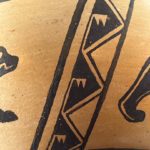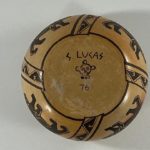This is an unusually thick bowl decorated with four bears, fairly crudely drawn, and a series of detailed pyramids. It is dated (19)76. Its creator, Steve Lucas, is known for his innovation and the extraordinary precision of his painting (cf 2021-18). Born in 1955, Steve would have been about 21 when he made this bowl and had not yet developed a focused interest in pottery making. This is the earliest pot of Steve’s that I have seen and it allows us to understand his work before he became a serious potter.
Form:
Both the bottom and the walls of this bowl are unusually thick, narrowing only at the lip. Rising from a 2.75-inch base, the walls curve outward about 1.25 inches and then smoothly turn inward another 1.625 inches to a 3-inch wide mouth. The bowl has a light blushing from the outdoor firing, with darker blushing in one quadrant and the rim above it.
Design:
About an inch below the rim a thick framing line encircles the pot. The design is monochromatic and has two design motifs: bears and pyramids, each repeated alternately four times. This design panel is 2-inches wide. A somewhat thinner framing line is painted below this central panel of design. All eight of the design renditions are also bracketed by vertical framing lines that run the height of the design panel. The result is that each of the renditions is surrounded on all four sides by framing lines and exists in its own space, visually independent of other design elements. The strip of pyramid motifs is a fraction of an inch longer than the sections with bears. As a result, the lower framing line is not continuous but is cut into four segments.
The four bears have the same format. I believe they were painted a solid black and then a pointed stylus was used to scrape away paint to delineate features. The head is topped by a black dot representing ears. Below is a white circle for an eye. The mouth is an unpainted squiggly line that turns upwards, perhaps representing the rear of the jaw. Where the neck meets the shoulder there is a splotchy area that looks like the paint was rubbed off or did not adhere. Since the same pattern exists on all four bears, this effect must be intended. The bears have three feet flat on the ground and their right rear foot lifted, as if about to take a step. The underbelly, and right rear legs are highlighted with additional etched lines.
The second design is drawn within two parallel lines that connect the framing lines and are drawn at a slight angle about 0.75 inches apart. A conjoint series of three pyramids on their edge fills most of this space. their bases a fraction of an inch distant from the left boundary of the design and their points touching the right boundary. These pyramids have a complex form. They have a solid black core, but this core is overlaid on the top surfaces by a thin line drawn a fraction of an inch above the core and following its parameters. Instead of just ending at the upper point of the top pyramid, this thin, unpainted, strip turns sharply to the left and terminates at the intersection of the top framing line and the right boundary of the design. Moreover, at the low points between pyramids, this unpainted one-lane highway branches off and tunnels into the pyramid to its left. These short tunnels end with two stacked unpainted isosceles triangles, like pendants on a flag pole.
Design Analysis:
As noted above, each of the eight renditions of design is surrounded by framing lines. As a result the design does not have unity, as if a sequence of stickers had been applied to the bowl to create the pattern of design.
To my eye the bears look like they were drawn by a talented high school artist. There’s nothing wrong with them, but they seem simple, stilted and a bit clunky. That splotchy area just behind the head is specially problematic. It’s repeated, so intentional, but I’m not sure what Steve intended. The texture is an experiment that did not work.
The most arresting design is the bears, but the most carefully-done is the sequence of three pyramids. The element of vertical pyramids is strikingly complex, when a simple row of black pyramids would have adequately filled this space.
I wonder if Steve ever studied the pyramids at Gaza, Egypt. There are three of them near each other and they were were built between 2550 BCE and 2490 BCE. The bulk of the structures uses a local limestone, but they were then faced with a whiter limestone, or sometimes granite. They are not solid structures but contain tunnels leading to burial chambers. Steve’s depiction of the three pyramids is close to a schematic diagram of these ancient structures.
Whereas the space devoted to the clunky bears is relatively large, the space devoted to the pyramids is small. Although small, the pyramid drawing is controlled and exact.
In contrast to the segmented design on this bowl, Steve’s mature work is marked by flowing and integrated design motifs. (Ex: 2010-23 and Artist List.) The contrast between the bear and pyramid designs is also a harbinger of Steve’s mature career. I don’t know how precise Steve’s figurative painting is today. Likely his 21st century bears would be more detailed and life-like than those seen on a pot made 46 years ago. Today Steve is recognized as among the very best potters from First Mesa. His fame is based on his detailed, perfect, execution of geometric compositions. That’s a skill abundantly clear on bowl 2021-20, a bit of an irony since the bears on the bowl are featured and the geometric pyramids seem secondary.
Charles King interviewed Steve Lucas about his career. His comments help create a context for the pot we have been discussing. Steve was raised in Gallup, but visited his relatives at Polacca, First Mesa, during the summers. Speaking of his perception of pottery-making relatives when he was young, Steve said:
“I really never paid much attention to what they were doing at the time. Dextra was always encouraging me and my cousins to take an interest in making pottery, but at the time it wasn’t a priority for me. Although I did produce a few pots during my stay at Polacca, they were pretty crude and somewhat simple….I think I even sold a few back then…In the late 1980’s, that’s when I started to seriously make pottery on my own…(King, 2017:89.”
Made at least 10 years before Steve “started to seriously make pottery,” bowl 2021-20 is apparently included in his comment “I did produce a few pots during my stay at Polacca, they were pretty crude and somewhat simple….I think I even sold a few back then (the 1970’s)…” The pot was collected by Al Alexander, Jr who began visiting Hopi every two weeks in the 1960’s to try to “fill out the family tree” of Nampeyo potters. See the “Note” at the end of the catalogue entry for 2020-18 for details. Bowl 2021-20, made in 1976, is not a great pot, but it is by a great potter who made it before he began his career. As such, it is an important marker of modern Tewa-Hopi pottery.

